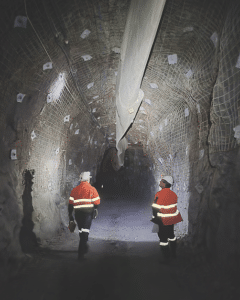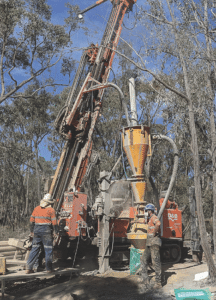Against a backdrop of surging prices, Australia is realising its place as a future antimony export partner.
Antimony has surged in interest across Australian investment portfolios, simultaneously driven by rising prices and the quality of local antimony exploration assets.
A key material for solar panels, antimony is also a central input for high-tech and defence applications. The critical mineral is also seen as a promising anode material for lithium-ion batteries.
While China dominates antimony production, making up 48 per cent of global output according to the latest United States Geological Survey, the country recently placed export controls on six antimony products, including antimony ore and antimony oxide.
This sent prices above $US25,000 per tonne (t), which is sure to impact the US, one of the world’s key antimony buyers.
The US, which uses antimony in a variety of defence products such as ammunition, nuclear weapons and night-vision goggles, consumed 22,000t of the critical mineral in 2023. China accounted for 63 per cent of these imports.
The antimony market’s reliance on China highlights the importance of alternative supply pathways, an area in which Australia is looming as a potential partner.
So which companies are advancing antimony projects in Australia?
Southern Cross Gold (ASX: SXG)
Sunday Creek, one of Australia’s most significant gold discoveries in recent times, doubles as an antimony project.
Southern Cross Gold has completed more than 130 drill holes for 58,494m at Sunday Creek since late 2020, with three high-grade mineralised domains delineated at the project: Rising Sun, Apollo and Golden Dyke.
The company made a new discovery at the Victorian asset in early September, with a 135m-wide gold-antimony zone identified below the Golden Dyke mine.
Drill hole SDDSC130 intersected seven high-grade veins over a 230m downhole interval, with visible gold discovered 10 times and nine assays returning more than 20 grams per tonne (g/t) gold, with up to 124g/t gold recorded.
The drill hole also returned 10 assays of more than five per cent antimony, with a peak grade of 31.5 per cent antimony.
“The scale of the Sunday Creek gold-antimony system continues to grow impressively,” Southern Cross Gold managing director Michael Hudson said. “This new discovery is located 260m and 600m west, respectively, of the Rising Sun and Apollo mineralised bodies.
“The expanding Sunday Creek system coupled with the 60km of diamond drilling planned over the next year means we are well on our way to meet our aim to double the size of the Sunday Creek exploration target.”
Larvotto Resources (ASX: LRV)
Larvotto’s Hillgrove antimony deposit is the largest in Australia and one of the 10 largest in the world.
The New South Wales project boasts a maiden ore reserve of 606,000 ounces of gold equivalent (AuEq) at six grams per tonne AuEq.

Image: Larvotto Resources
Larvotto has forecast $73 million of capital expenditure to develop an operation capable of producing 80,000 ounces (oz) AuEq per year, comprising 41,100oz of gold and 5400t of antimony.
A pre-feasibility study (PFS) demonstrated Hillgrove’s economics at spot and base gold and antimony prices, with the spot estimation highlighting the project’s profitability at current record gold and antimony prices.
Hillgrove has a post-tax net-present value (NPV) of $157 million at base prices ($US2000/oz for gold and $US15,000/t for antimony) and a post-tax NPV of $383 million at spot prices ($US2350/oz for gold and $US23,000/t for antimony).
Following the completion of a definitive feasibility study and a positive final investment decision, Larvotto is targeting first ore by early 2026.
“All financial and technical objectives have been met and the capital cost of the development is low compared to a greenfields development, with much of the required surface and underground infrastructure already in place,” Larvotto managing director Ron Heeks said when the PFS was released.
“Larvotto will be bringing Australia’s largest antimony project online in a rising antimony market, driven by the increasing use of antimony in solar panel production whilst production from other global producers becomes stressed.”
Iltani Resources (ASX: ILT)
Iltani is advancing two unique critical minerals projects: the Orient project is Australia’s largest silver-indium deposit, while the Antimony Reward project is being re-examined for its antimony potential.
Orient and Antimony Reward form part of the Herberton project in Queensland and are located a stone’s throw from each other.
A recent mapping and sampling program at the Antimony Reward project confirmed the presence of significant antimony mineralisation across two key vein systems.
A total of 19 samples were taken from two vein systems. The first system produced an assay result of 16.2 per cent antimony, with a maximum result of 46.5 per cent, while the second returned an average of 10.9 per cent antimony, peaking at 17.7 per cent.
Iltani has designed a 15-to-20-hole (1500m) reverse circulation drilling program at Antimony Reward. The company hopes to commence this campaign by early October.
“We are extremely excited about the potential of the Antimony Reward system to deliver a high-grade resource and, amid the antimony price surge, there is not a better time to be doing this work,” Iltani managing director Donald Garner said.
“The antimony mineralisation sampled … to date contains exceptionally low arsenic. Arsenic is a key penalty element with regards to antimony concentrates, so this is another good sign.”
Kalamazoo Resources (ASX: KZR)
Kalamazoo holds a promising exploration portfolio in the Victorian Goldfields, where the South Muckleford project holds the potential to produce antimony in the coming years.
The explorer believes South Muckleford is analogous to Australia’s only antimony producer, the Costerfield mine, and the revered low-cost Fosterville gold mine.

Image: Kalamazoo Resources
Field programs in 2020–21 identified historic mine workings coincident with gold-antimony mineralisation. Gold production at Fentiman’s Reef in the late 1800s was associated with high-grade antimony lodes containing up to 42 per cent antimony.
After conducting a review of South Muckleford, Kalamazoo is carrying out a follow-up program of 3D structural geology modelling as it aims to identify extensional and potentially deeper targets along the project’s defined reef structures.
Kalamazoo chief executive officer Luke Mortimer detailed the opportunity at hand.
“The central Victorian Goldfields are emerging as a significant high-grade gold-antimony geological province,” he said.
“This is a potentially significant development for Kalamazoo, which holds a substantial 2000-square-kilometre exploration package in the region.”
Trigg Minerals (ASX: TMG)
Trigg recently acquired a pair of high-grade antimony assets in NSW, one of which is located adjacent to Larvotto’s Hillgrove project.
The Taylors Arm project contains the Testers mine, which boasts massive stibnite veins of up to 63 per cent in antimony grade, which Trigg believes is Australia’s highest recorded antimony grade.
The Swallows Nest mine extracted antimony from 1940 to 1955 at 40 per cent antimony, with recent rock sampling identifying grades as high as 31.4 per cent antimony.
Overall, the Taylors Arm tenement includes 71 historical workings across six mineral camps with a widespread occurrence of stibnite, the primary ore for antimony. Trigg believes the project could host antimony mineralisation or a gold-antimony association similar to the Hillgrove project. There is also the potential for polymetallic deposits.
Trigg recently commenced a maiden exploration program at Taylors Arm, with the company engaging Dirt Exploration’s Neil Pendock to conduct remote and geophysical surveying.
The company also acquired the Spartan antimony project in its acquisition, which borders Larvotto’s Hillgrove project. Spartan covers part of the Hillgrove fault.
This feature appeared in the November 2024 issue of Australian Mining.



